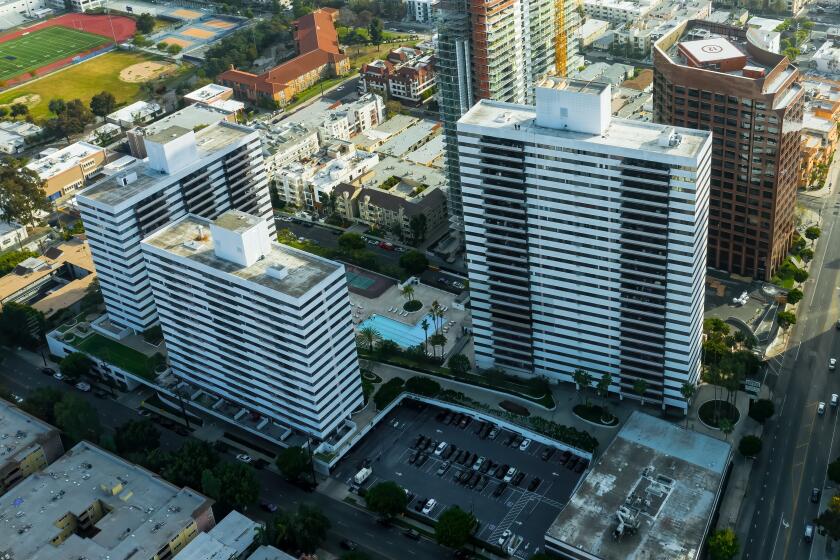Opinion: I’m a tenant in the mass eviction at Barrington Plaza. This developer decision could devastate L.A.

- Share via
“Hell, no, we won’t go!” The spirited chant sounded familiar, although it had been 51 years since I last shouted it alongside other demonstrators.
This time, instead of protesting the Vietnam War at UC Berkeley’s Sproul Plaza, I stood with 25 other impassioned tenants on a corner of Wilshire Boulevard in West Los Angeles, in front of Barrington Plaza — the apartment complex from which we are being unlawfully evicted.
My motivations for participating in both were altruistic and self-serving. I opposed the war in Vietnam on moral grounds, appalled by the unnecessary devastation, but I also did not want to join the thousands of Americans who had already perished in it.
Three months after the end of pandemic-era eviction protections, the owner of Barrington Plaza has initiated one of the largest mass evictions in L.A. in recent years.
I’m helping to organize the tenants’ resistance to the eviction to preserve my own home, but I’m equally motivated to protect our community, especially my fellow boomers, some of whom suffer from dementia, diabetes or cancer.
The multibillion-dollar corporate landlord and developer, Douglas Emmett, decided to evict all the largely working-class tenants from their 577 occupied units in one of the biggest rent-stabilized buildings on Los Angeles’ pricey Westside. The company says it intends to retrofit the fire sprinkler system, following dangerous fires in 2013 and 2020, and make other needed repairs. Yet if it requires units to be vacant to do the work, the city requires the filing of a Tenant Habitability Plan, under which tenants should be temporarily relocated, not evicted.
Emmett is also claiming the Ellis Act as justification for the mass eviction. Passed in 1985, this California law was created to allow landlords to evict tenants from rent-controlled units that they plan to take off the rental market. But the company won’t commit to removing Barrington Plaza from the rental market when the renovations are complete, and they may gentrify and then re-rent the units at inflated market prices.
Another inescapable irony: Barrington’s eviction announcement came on May 8, the same date in 1959 that Los Angeles officials used eminent domain and other political machinations to bulldoze Chavez Ravine and destroy the homes of that vibrant, historic Mexican American community to make way for Dodger Stadium. If the Barrington evictions go through, they’ll join Chavez Ravine as among the largest evictions in the city’s history.
While I watched L.A.’s rush-hour traffic crawl by our tenant protest, many of the vehicles honking in support of our ragtag crew carrying signs and joined by our dogs, I reflected that this time the power we were fighting was not the military-industrial complex, but “Big Development” and corporate greed. Emmett donated $400,000 to the campaign of the current City Council member for Barrington Plaza’s district.
Los Angeles Housing Department’s decision to allow these evictions sets a dangerous precedent as new mandates to residential buildings are coming.
The wonderfully inclusive, intergenerational, international community at Barrington represents the best of L.A., with a wide range of jobs and backgrounds. Tenants I’ve spoken with since we received notice include an Uber Eats driver, a waitress at El Pollo Loco, a professional dog walker, a Beverly Hills hairstylist and others who service our more affluent Westside neighbors.
Many of us, myself included because of the current writers’ strike, are on some form of government assistance. Others, even more vulnerable, are still financially recovering from the COVID pandemic and struggling with child-care costs; or are elderly and disabled, depending on nearby loved ones for trips to go shopping or attend medical appointments.
One tenant I spoke with has suffered with PTSD from rape and attempted murder. She previously lived in her car. For her, the very real possibility of losing her apartment triggers sleepless nights along with anxiety, depression and panic. Another tenant has worked for the county assisting homeless people in South Central for 20 years. Now she could be relocated to the same neighborhood where she spends her days helping those who live in makeshift tents on the street.
We are facing either imminent relocation to a distant part of the city, a premature placement in an extended care facility — or homelessness.
This tragedy is not just about us. At stake is the fate of an entire city where more than 75,000 people are homeless on any given night. If Emmett’s mass eviction is allowed to stand, it will displace hundreds of us, set a devastating precedent for rent-stabilized housing in Los Angeles and unleash a catastrophic burden on our already strained social services.
Our Barrington Plaza Tenant Assn. is working with the Coalition for Economic Survival to fight our eviction, and we’ve created a GoFundMe page to collect donations. It will take all of us to stop Douglas Emmett’s unlawful use of the Ellis Act.
A lot has changed since I was a 20-year-old, long-haired activist who chanted, “Hell, no, we won’t go!” at a Vietnam War rally. But the stakes for this community are just as high now.
Robert Lawrence is a producer whose films include “Clueless,” “Die Hard with a Vengeance,” “Rapid Fire” and “Rock Star.”
More to Read
A cure for the common opinion
Get thought-provoking perspectives with our weekly newsletter.
You may occasionally receive promotional content from the Los Angeles Times.












